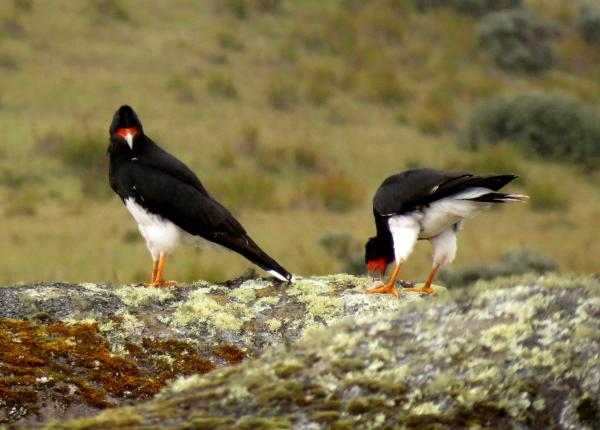How The Peregrine Fund is Helping
Though The Peregrine Fund doesn't work directly with Mountain Caracaras, our efforts in scientific research, habitat conservation, education, and community development help conserve birds of prey around the world. We also supply literature to researchers from our avian research library, which helps scientists around the world gather and share important information on raptor conservation. Additionally, through the Neotropical Raptor Network, we promote communication and collaboration among researchers and conservationists in the Neotropics, where this small owl lives.
Where They Live
The Mountain Caracara is a neotropical species, and makes its home in parts of Ecuador, Peru, Bolivia, northwestern Argentina and central Chile. It favors habitats within the high Andes, and spends most of its time in the puna zone - a treeless plateau void of trees, at 3,500-5,000 m - but does descend regularly to the coast in Peru. This bird spends its time in grasslands, around montane lakes, in heavily grazed areas, and on recently plowed land.
What They Do
The Mountain Caracara is arguably one of the most beautiful of the caracaras. It has a pitch black head, back, bib, and wings which contrast beautiful with its snowy lower breast, rump and underwing-coverts, and tail edge. Its legs are a bright orange-yellow, and it has a bare facial patch of reddish skin. Juveniles look quite differently from the adults, as they are predominantly rufous brown.
When on the search for this bird, it is best to look at ground level. These caracaras spend a lot of time walking, whether alone, in small family groups, or sometimes even in flocks of more than a hundred birds! Now that would be a sight to see.
Unlike the very vocal and loud Yellow-headed Caracara, the Mountain Caracara tends to be silent, except for the occasional raspy calls they emit, often when they are alarmed.
Why They Need Our Help
This large caracara is categorized as a species of "Least Concern" by BirdLife International. Thankfully it seems to be common throughout its range and doesn't appear to be facing any immediate, major threats.
What They Eat
Like most other caracras, the Mountain Caracara can best be described as an opportunistic feeder - meaning it will catch and feed upon whatever crosses its path and is relatively easy to take. It feeds mostly on live lizards and rodents, but it also patrols city dumps in search of something to eat, or feeds on carrion alongside Andean Condors.
Nests, Eggs, and Young
When breeding season begins, pairs of these caracaras will engage in some lovely aerial displays including soaring and circling together high up in the sky.
Caracaras, unlike many falcon species, build their own nests. However, you learned that Mountain Caracaras tend to inhabit areas with very few, if any, trees. So, sticks and twigs can sometimes be hard to come by. In many cases, these caracaras lay their eggs in structures composed mostly of dry cow dung, which is a fancy word for poop. These nests are often placed on rock ledges. However, some Mountain Caracaras build their nests on top of electricity towers. These nests are composed of larger sticks that are interwoven with llama's or sheep's wool.
The female will lay 2-3 eggs that are creamy-white and heavily suffused with reddish-brown pigment.
Mountain Caracara and the World Center for Birds of Prey
The World Center for Birds of Prey offers fun ways to learn about birds of prey. Interactive activities, tours, interesting videos and a children's room with activities from coloring sheets to quizzes to costumes are all available for our visitors. Falcons are included among the education birds at the center, providing visitors with a wonderful opportunity to see these birds up close and learn about the wonderful and interesting adaptations they have in order to survive in their respective habitats. There is also a touch table with feathers and other natural objects available for exploration.
References:
Bierregaard, R. O. and G. M. Kirwan (2020). Mountain Caracara (Phalcoboenus megalopterus), version 1.0. In Birds of the World (J. del Hoyo, A. Elliott, J. Sargatal, D. A. Christie, and E. de Juana, Editors). Cornell Lab of Ornithology, Ithaca, NY, USA. https://doi.org/10.2173/bow.moucar1.01
Global Raptor Information Network. 2021. Species account: Mountain Caracara Phalcoboenus megalopterus. Downloaded from http://www.globalraptors.org on 11 Sep. 2021









